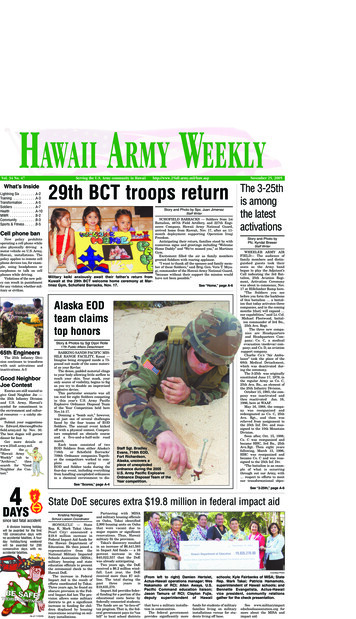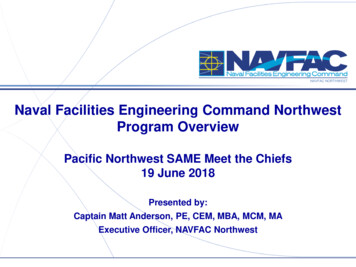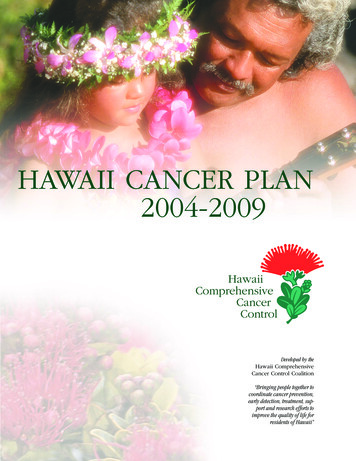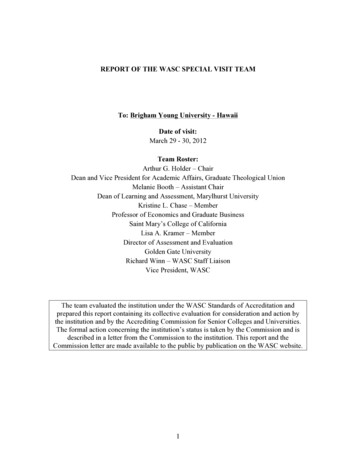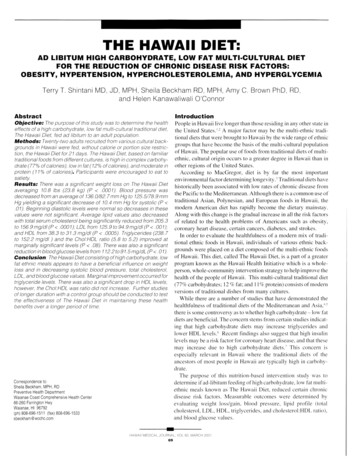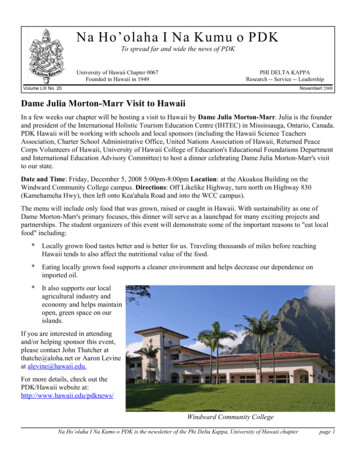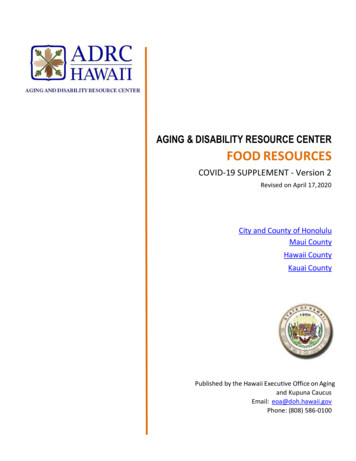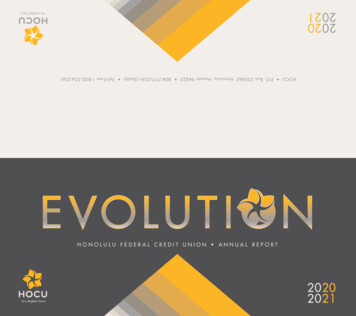
Transcription
NAVFAC HAWAIIDesign-Build at NAVFACHawaiiNAVFAC Pacific Designer Builder Symposium 2010NAVFAC Hawaii Capital ImprovementsDesign DivisionDecember 2010
Session Overview NAVFAC Hawaii– Who we are, our relationship to NAVFAC Pacific– Workload projections, construction contracts and A-E services Why Design-Build– How does Design-Build support our mission Design-Build– Design-Build basics– How does NAVFAC Hawaii do Design-Build.– What are similarities or differences to NAVFAC Pacific. New Developments and On-going Topics– Desirables and Betterments– Collateral equipment– Shop drawings required as part of Final design documentation– CCASS evaluations Related Sessions– Order of Precedence– Sustainability– Panel Discussion2December 2010
NAVFAC OrganizationNAVFACHQEchelon 2Echelon 3Echelon ACPacificNAVFACFar EastNAVFACEurope3Commander, NAVFAC AtlanticCommander, NAVFAC PacificRDML Kevin R. SlatesRDML Kate Gregory
NAVFAC OrganizationBusiness/Support LinesCommandsNAVFAC HQNF LANTNF PACAsset ManagementNavy Crane CenterNAVFAC Engineering Service CenterNAVFAC Expeditionary Logistics CenterNAVFAC JapanNAVFAC GuamNAVFAC HawaiiNAVFAC PACChief Information OfficerNAVFAC SouthwestFinancial ManagementNAVFAC NorthwestSmall BusinessNAVFAC EuropeSafetyNAVFAC MidwestAcquisitionNAVFAC SoutheastPublic WorksNAVFAC Washington4Capital ImprovementsNAVFAC Mid-AtlanticHorizontal:1. Business Processes2. Resource Allocation3. Community Mgmt4. Corporate Metrics5. NAVFAC ProgramMgt/ExecutionEnvironmentalNAVFAC LANTVertical:1. MissionAccountability2. Client Interface3. Project Mgt/Execution4. PerformanceCounselDecember 2010
NAVFAC HAW AI I - W ho are w e?5 Established 10 March 2005 Highly diverse, talented organization Large employer of local trade and white-collarexpertise. Approximately 1,600 civilians and 120 architects and engineers in theCapital Improvement Business Line. Added Air Force civilians & military –Oct. 1, 2010 due to joint basing. Provides: engineering & contracting expertise, maintenance, repair,demolition, environmental, utilities (electricity, water, steam, air, &wastewater treatment), base development, maintains & leases vehicles.
Capital I m provem ents – Project Type NAVFAC Hawaii is the Navy's single touch-point for most facilities engineering productsand services in Hawaii- Some projects executed by NAVAC Pacific Provides service to Marine Corps, Air Force, and Army State of Hawaii Area of Responsibility (AOR) Wide range of projects:– Military Construction (MILCON) Mission funded – provided directly to the command from the Federal budget via Congressionalappropriation , multi-year process Typically new buildings, large renovations Awarded on stand-alone as well as MACC task orders contracts Typically A-E contract document preparation– Special Projects Locally funded 400,000 Typically renovations, can include new buildings Multiple Award Construction Contract (MACC), or Indefinite Delivery Indefinite Quantity (IDIQ)contracts Mostly A-E contract document preparation, some in-house– Sustainment, Restoration, and Modernization (SRM) Repair and renovation projects 400,000 MACC, Multi-trade and single trade IDIQ Typically in-house contract document preparation6December 2010
W ork load Trends: NAVFAC Haw aiiDesign Projection350300MILCONMillions 250200SpecialProjects150SRM via IDIQContracts10050SRM via ShopConstruction0FY107FY11FY12FY13FY14FY15December 2010
W ork load Trends: NAVFAC Haw aiiConstruction Projection8
W hy Design-Build? NAVFAC Objectives and Considerations– For Navy and Navy Reserve Military (MCON/MCNR), acquisition strategy goal of 75%Design-Build, 25% Design-Bid-Build. Policy set by HQ.– For MILCON and other projects, execution method is more flexible, local commanddecision based on workload, schedule, available funds.Advantages of Design-Build: Shorter duration from initial design to contract award than traditional Design-BidBuild (DBB) Fiscal year obligation. Difficult to reprogram a congressionally appropriated project.Limits to additional program area and cost. Less contentious, partnership. Suited for standardized building types, or conversely technically complex projectsrequiring non-standard design and construction.9December 2010
W hat is Design-Build? Design-Build is a construction project delivery system where design andconstruction are contracted with a single entity known as the design-builder ordesign-build contractor. A “2-party” agreement. Typically, a General Contractor is the prime contractor who subcontracts a designteam. By contrast, Design-Bid-Build is a traditional “3-party” agreement betweenseparate design and construction entities. Design-Build is defined by the contract, not the format of the Request forProposal (RFP). The RFP describes the project requirements and is a contract document. “Design” is the construction documentation that the project is constructedfrom. The project is not constructed from the RFP. The Design-build entityprepares the construction documentation.10December 2010
Design-Build dFacility11December 2010
NAVFAC Design-Build NAVFAC has been utilizing DB since the late 1980’s NAVFAC’s Chief Engineer in FY2001 initiated a single Design-BuildProcurement Format– Create common business practices across NAVFAC– Utilize Navy and DoD Criteria, Standards, Specifications, and lessonslearned– Utilize Uniformat as a basic information structure– Develop performanced based requirements Navy chose to create one Design-Build Master (NDBM) request forproposal template (RFP) that covered as many building types aspossible– Template versus identical RFP’s– Flexibility within template Continuous improvement and evolution12December 2010
NAVFAC Design-Build M aster – R esourcesW hole Building Design Guidewww.wbdg .org/ndbm13December 2010
NAVFAC Design-Build M aster – 6 Part Form atProposal Forms & DocumentsPART 1PART 2General RequirementsPART 3Project ProgramPART 4Performance TechnicalSpecificationsPrescriptive SpecificationsPART 5PART 6Attachments14December 2010
NAVFAC Design-Build M aster – Part 2GENER AL R EQUI R EM ENTSPART201 14 00.05 20 WORK RESTRICTIONS01 20 00.05 20 PRICE AND PAYMENT PROCEDURES01 30 00.05 20 ADMINISTRATIVE REQUIREMENTS01 31 19.05 20 P OST AW ARD M EETI NGSTable ofContentsDivision0101 32 16.00 20 DESIGN & CONSTRUCTION PROGRESSDOCUMENTATION01 32 17.05 20 NETWORK ANALYSIS SCHEDULES (NAS)01 33 00.05 20 CONSTRUCTI ON SUBM I TTAL P ROCEDURES01 33 10.05 20 DESI GN SUBM I TTAL P ROCEDURES01 35 13.05 20 SPECIAL PROJECT PROCEDURES01 35 29.05 20 SAFETY AND OCCUPATIONAL HEALTHREQUIREMENTS01 45 00.05 20 DESI GN AND CONSTRUCTI ON QUALI TYCONTROL01 50 00.05 20 TEMPORARY FACILITIES AND CONTROLS01 57 19.05 20 TEMPORARY ENVIRONMENTAL CONTROLS01 57 19.01 20 SUP P LI M ENTARY TEM P ORARY EV CONTROLS01 74 19.05 20 CONSTRUCTION AND DEMOLITION WASTEMANAGEMENT01 78 24.05 20 FACI LI TY OP ERATI ON AND M AI NTENANCESUP P ORT I NFORM ATI ON (OM SI )15December 2010
PART2NAVFAC Design-Build M aster – Part 2Part 2 Preparation Part 2, General Requirements are NOT BOILERPLATE Do not download from Whole Building Design Guide website. Many NAVFAC Hawaii specific requirements:– Safety, Environmental, Client (PHNSY and IMF, MCBH) Many project specific requirements:– Post award meetings, design and construction submittals,quality control– Even for MACC contracts that have General Requirementsin the basic contract, substantial amount of editing requiredfor each task order.– How Part 2 is prepared depends on the type of contractand who is preparing AE prepared: MILCON, Special Projects In-house: SRM16December 2010
PART2NAVFAC Design-Build M aster – Part 2Part 2 PreparationAE prepared RFP: Differences between NAVFAC Hawaii Design Managers, noteveryone it does the same way. MACC RFP’s will be essentially similar to stand-alone contracts– all applicable sections should be included. Generally, NAVFAC Hawaii will provide edited worddocuments without header/footers. AE’s should confirm with the NFH Design Manager. MACC contractors note that task order requirements supersedebasic contract requirements.In-house prepared RFP: Usually MACC task orders. May only include edits to the basic contract requirements.17December 2010
NAVFAC Design-Build M aster – Part 3PR OJECT PR OGR AMPART3MasterFormatTABLE OF CONTENTS1. PROJECT DESCRIPTION2. PROJECT OBJECTIVES2.1 Mission Statement2.2 Facility Function2.3 Project Specific Priorities2.4 Appropriate Design2.5 Workflow Process2.6 Special Design Challenges2.7 Adaptability and Flexibility3. SITE ANALYSIS3.1 Existing Site Conditions3.2 Site Development Requirements4. BUILDING REQUIREMENTS4.1 Space Tabulation (EXCEL form at http:www.wbdg.org/ndbm/download)4.2 Space Relationships4.3 Exterior Character5. ROOM REQUIREMENTS6. ENGINEERING SYSTEMS REQUIREMENTSA10 FoundationsD40 Fire Protection SystemsA20 Basement ConstructionD50 Electrical Power & LightingB10 SuperstructureE10 EquipmentB20 Exterior EnclosureE20 FurnishingsB30 RoofingF10 Special ConstructionC10 Interior ConstructionF20 Selective Building DemolitionC20 StairsG10 Site PreparationsC30 Interior FinishesG20 Site ImprovementsD10 ConveyingG30 Site Civil/Mechanical UtilitiesD20 PlumbingG40 Site Electrical UtilitiesD30 HVACG90 Other Site ImprovementsDecember 2010Consists of6 ChaptersProjectProgramCOVERPAGECover PageTable ofContents“Basis of Design” Data.Obtain majority of the dataduring the FACD/charrette.18
PART3NAVFAC Design-Build M aster – Part 3w w w .w bdg.org/ ndbmBrowseDownload:Individualparts, or entiretemplate19December 2010
PART320NAVFAC Design-Build M aster – Part 32.0 Project Objectives – Sustainable designDecember 2010
PART3NAVFAC Design-Build M aster – Part 32.0 Project Objectives – Sustainable designLEED v3:Updates ECB2008-01 creditrequirements.Feasibility ofcredits shouldbe verifiedduring FACD, oras early duringRFP prep aspossible21December 2010
PART3NAVFAC Design-Build M aster – Part 35.0 R oom R equirem entsRoom requirements identifiedPart 3 and usually Part 6 –RFP drawings as well22December 2010
PART3NAVFAC Design-Build M aster – Part 36.0 Engineering System R equirem ents – ESRESR’s organizeddifferently than CSIformatBrowse23December 2010
PART3NAVFAC Design-Build M aster – Part 36.0 Engineering System R equirem ents - ESR6.0 ENGINEERING SYSTEMS REQUIREMENTSA10 FOUNDATIONSA20 BASEMENT CONSTRUCTIONB10 SUPERSTRUCTUREB20 EXTERIOR ENCLOSUREB30 ROOFINGC10 INTERIOR CONSTRUCTIONC20 STAIRSC30 INTERIOR FINISHESD10D20D30D40D50CONVEYINGPLUMBINGHVACFIRE PROTECTION SYSTEMSELECTRICAL“Engineering Systems”correspond with PART 4 PTSsusing the UNIFORMAT numberingsystemE10 EQUIPMENTE20 FURNISHINGS24December 2010
PART3NAVFAC Design-Build M aster – Part 36.0 Engineering System R equirem ents - ESRESR C10 Interior Construction - exampleUniformat Number:correlates to RoomRequirements aswell as Part 4Do not deleteunused paragraphs,indicate “Not Used”25December 2010
NAVFAC Design-Build M aster – Part3Sum m aryPART326 Part 3, Project Program is project specific and thedownloaded template must be edited. Use the Browse feature of the WBDG website to assistediting. Part 3 is the most important part of the RFP, conflictsbetween Part 3 and other parts are governed by the Order ofPrecedence Clause. Often additional room requirements are referred to in Part 6,RFP drawings. This requires careful coordination. Uniformat numbering correlates Engineering SystemRequirements with Part 4, Performance TechnicalSpecifications. Part 3 ESR’s control how Part 4 is applied tothe project.December 2010
PART4NAVFAC Design-Build M aster – Part 4Perform ance Technical Specifications - PTSPTS’s organizedexactly the same asPart 3 ESR’s27December 2010
NAVFAC Design-Build M aster – Part 4PART428P erform ance Technical Specifications - P TS P TSs corresponds to P art 3 , “Engineering SystemsRequirements” via the Uniform at num bering system PTSs identify: Design Criteria (UFC, UFGS, Industry Codes, etc.) Field Verification & Acceptance Testing Performance & Quality of Facility ElementsDecember 2010
PART4NAVFAC Design-Build M aster – Part 4P ERFORM ANCE TECHNI CAL SP ECI FI CATI ONS (P TS) PTS states how a “built element” must performwithout dictating how to design or construct it.States criteria that applies regardless of the designsolution. (e.g. Windows shall meet AT/FP, 175 mphwinds, not leak, last 15 years) P art 3 ESR : W hat you w ant in the project P art 4 P TS: How those elem ents m ust perform 29ESR’s are editedPTS’s are NOT editedDecember 2010
PART4NAVFAC Design-Build M aster – P art 4P ERFORM ANCE TECHNI CAL SP ECI FI CATI ONS (P TS)PTS C10 Interior Construction - example30December 2010
PART4NAVFAC Design-Build M aster – Part 4Draft Uniform Facilities Criteria - UFCDraft UFC’s apply toDB projects. WBDG“Design Guidance”31December 2010
PART432NAVFAC Design-Build M aster – Part 4Draft Uniform Facilities Criteria - UFCDecember 2010
PART5MasterFormatInteriorCoatingOf SteelTanksNAVFAC Design-Build M aster – Part 5PR ESCR I PTI VE SPECI FI CATI e13112CathodicProtectionSystem(Steel WaterTanks)33Only use prescriptivespecifications (UFGS)when performancespecifications are notpractical. Intent is tohave zero or minimalUFGSs. (Sections shownare for example only.)December 2010
PART6MasterFormatNAVFAC Design-Build M aster – Part 6ATTACHM ENTSTABLE OFCONTENTSPermits Record of Decisions(PROD) FormGeotechnical ReportSite Survey:Asbestos & LeadPaint ReportsDrawings& SketchesAttachmentsmay be:8-1/2 X 11,11 X 17 orD-Size DrawingsOthers as required34December 2010
DESI GN -BUI LD AT NAVFAC HAW AI IBridging Docum ents Bridging documents are included in Part 6 as attachments. Bridging documents are considered prescriptiverequirements. If included, they need to be carefully coordinated with theother requirements of the RFP. There is not a set “percentage of design” that definesbridging documents. When bridging documents should be considered:– When a specific configuration is important– When Historic consultation is required prior to award– When price will be a factor in determining award Does not preclude changes after award35December 2010
NAVFAC Design-Build M asterORDER OF P RECEDENCEThe contract consists of solicitation, approved proposal, & final design.NFAS Clause 5252.236-9312 and UFGS 01 33 10.05 20 (Design Submittal Procedures)determine the precedence in case of a conflict. In the event of conflict orinconsistency between any of the below described portions of the conformedcontract, precedence shall be given in the following order:a. Any portions of the proposal or final design that exceed the requirements of thesolicitation.(1) Any portion of the proposal that exceeds the final design.(2) Any portion of the final design that exceeds the proposal.(3) Where portions within either the proposal or the final design conflict, theportion that most exceeds the requirements of the solicitation has precedence.b. The requirements of the solicitation, in descending order of precedence:(1) Standard Form 1442, Price Schedule, and Davis Bacon Wage Rates, (2) Part 1- Contract Clauses, (3) Part 2 - General Requirements, (4) Part 3 - ProjectProgram Requirements, (5) Part 6 - Attachments (excluding Concept Drawings),(6) Part 5 - Prescriptive Specifications exclusive of performance specifications,(7) Part 4 - Performance Specifications exclusive of prescriptive specifications,(8) Part 6 - Attachments (Concept Drawings).36December 2010
NAVFAC Design-Build M aster – M odel R FPs37December 2010
DESI GN -BUI LD AT NAVFAC HAW AI IAcquisition Strategy ACQUISITION STRATEGY INFLUENCES RFP– DETERMINATION OF HOW THE CONTRACT WILL BE AWARDED IS A KEYCONSIDERATION AND WILL DIRECTLY IMPACT THE DESIGN PROCESS ANDCONTENT OF THE RFP.– WHAT TYPE OF CONTRACT WILL BE USED, STAND ALONE, MACC (WHICH ONE),SMALL BUSINESS– MACC TASK ORDER RFP’S: CANNOT BEGIN TO PREPARE THE RFP WITHOUTCONFIRMATION OF SPECIFIC CONTRACT TO BE WRITTEN AGAINST. THIS IS MOREOF A CONSIDERATION FOR IN-HOUSE RFP PREPARATION THAN AE.– TWO BASIC STRATEGIES ARE: 38BEST VALUELOW PRICE TECHNICALLY ACCEPTABLE (LPTA)December 2010
DESI GN -BUI LD AT NAVFAC HAW AI IAcquisition Strategy ACQUISITION STRATEGY – BEST VALUE: WILLBE USED EXTENSIVELY IN FY2011 AND LIKELY FY 2012 REQUIRES BOARD SELECTION WILL INVOLVE DESIRABLES AND BETTERMENTS CAN BE USED FOR MACC TASK ORDERS OR STAND-ALONE CONTRACTS PRO: USED TO MAXIMIZE APPROPRIATION OR FUNDING CON: TIME CONSUMING TO SELECT AWARDEE39December 2010
DESI GN -BUI LD AT NAVFAC HAW AI IAcquisition Strategy ACQUISITION STRATEGY - LOW PRICE (TECHNICALLYACCEPTABLE):– AWARD BASED ON PRICE– USUALLY USED ON MACC TASK ORDERS– CAN BE USED ON STAND-ALONE AWARDS– REQUIRES A PRESCRIPTIVE ORIENTED RFP (BRIDGING DOCUMENTS):COMPARE APPLES TO APPLES PRO’S: FASTER, MORE STRAIGHTFORWARD AWARD PROCESS CON: NOT ABLE TO MAXIMIZE APPROPRIATION OR FUNDING AS WELL AS BESTVALUE40December 2010
DESI GN -BUI LD AT NAVFAC HAW AI INew Developm ents and On-going Topics DESIRABLES AND BETTERMENTS:– Evaluated as part of the technical evaluation, in addition to price, todetermine Best Value for the government.– Typically used for MILCON projects, but not limited to.– Intent: Maximize appropriation with an emphasis on minimizing TotalOwnership Cost Desirables: Government stipulated Betterments: Offeror proposed– Sample Basis of Award requirement:“ Offerors shall identify desirables and/or betterments that have been providedwithin their proposal while still remaining within the stated budget. A bettermentis an applicable improvement/enhancement that provides quality and/or value tothe basic RFP requirement”41December 2010
DESI GN -BUI LD AT NAVFAC HAW AI INew Developm ents and On-going Topics DESIRABLES AND BETTERMENTS:– Desirables: Listed in order of preference Include criteria for each desirable in Parts 3 and 4. Very important toprovide sufficient criteria, similarly to any other project requirement,and to coordinate within the RFP. Sample desirables may include:–––––Enhanced CommissioningSolar Domestic Hot Water SystemsBuilding Integrated or Mounted Photovoltaic Energy Generation SystemAdvanced MeteringImproved Energy Performance – achieve energy consumption levels 40%below ASHRAE Standard 90.1 May include other features not energy related. Must be within thescope of the project/DD 1391.42December 2010
DESI GN -BUI LD AT NAVFAC HAW AI INew Developm ents and On-going Topics DESIRABLES AND BETTERMENTS:– Betterments: Proposal Submission Requirements would typically provide guidance:“ reduce energy/utility consumption, reduce the total cost of ownership,and/or increase the reliability, maintainability and/or accessibility of thefacility ” Pricing shall be provided for each Betterment.– Would be used during the best value trade-off analysis.Technical evaluation completed first, then price.43December 2010
DESI GN -BUI LD AT NAVFAC HAW AI INew Developm ents and On-going Topics Collateral Equipment:– “Turn-key” method for Design-Build is now preferred. Traditionally, Govt or Govt’s AE have prepared Collateral Equipment (CEQ)buy packages and procured and installed. This is still typical for Design-BidBuild contracts.– Only applies to Furniture, Fixtures, and Equipment ( FF&E) Examples would include modular furniture, workstations, seating, filing,training and conference furniture, window treatments. Would exclude certain types of equipment. Confirm with NAVFAC.44December 2010
DESI GN -BUI LD AT NAVFAC HAW AI INew Developm ents and On-going Topics Collateral Equipment:– “Turn-key”: Govt AE prepares a partial FF& E Buy Package – “60%” This will be included in the RFP or solicitation package Sample Govt AE SOW:For DB projects, the A-E shall include a 60% CEQ Buy Package submittalwith the DB RFP solicitation package, which shall include the following :- Collateral Equipment Summarized List (Cost Estimate to includefreight, installation, contingency and procurement fees)- Procurement Data Sheets (description of each CEQ item, vendorinformation, GSA contract number)- Catalog Cuts- Furniture Placement Plans based on the concept design45December 2010
DESI GN -BUI LD AT NAVFAC HAW AI INew Developm ents and On-going Topics Collateral Equipment: Design-Builder completes the Buy Package– Assures most current user/client requirements– Assures coordination with Final Design, changes from the RFP 46Buy Package must be reviewed by the client, FF & E funding source, andNAVFAC Interior Designer/CEQ Manager.December 2010
DESI GN -BUI LD AT NAVFAC HAW AI INew Developm ents and On-going Topics Shop Drawings required as part of Final Designdocumentation: CCASS evaluations to include Designer of Record(DOR) evaluations.47December 2010
NAVFAC HAWAIIQuestions?NAVFAC Hawaii Capital ImprovementsDesign DivisionDecember 2010
Uniformat numbering correlates Engineering System Requirements with Part 4, Performance Technical Specifications. Part 3 ESR’s control how Part 4 is applied to the pr
